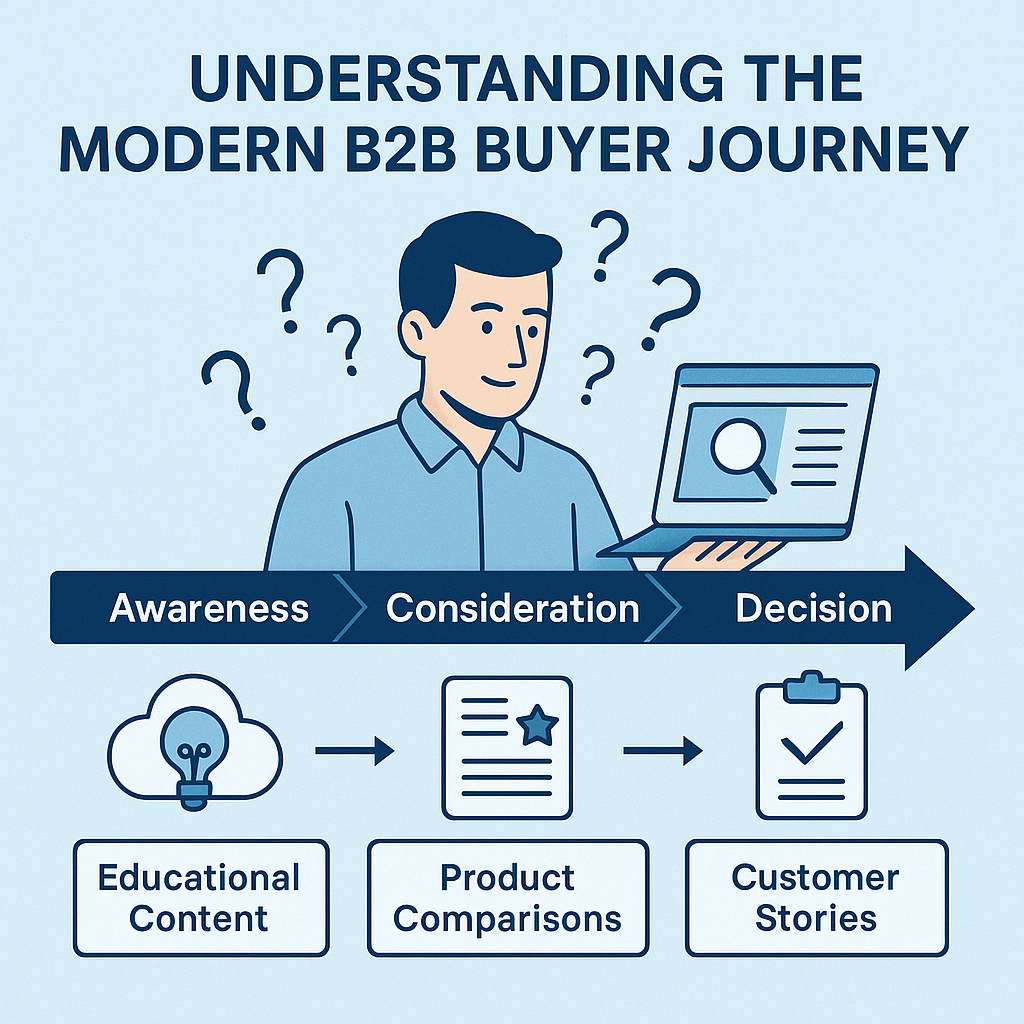The B2B buying process has evolved dramatically over the past decade. Today’s buyers conduct extensive research independently, consuming multiple pieces of content before ever engaging with sales. As content marketers and demand generation professionals, we need to understand this reality and align our content strategy accordingly.
Effective buyer journey mapping isn’t just about creating content—it’s about creating the right content at the right time to guide prospects through their decision-making process. When you master this alignment, you’ll see higher engagement rates, shorter sales cycles, and better qualified leads flowing to your sales team.

Understanding the Modern B2B Buyer Journey
Before diving into content funnel stages, let’s establish what the B2B buyer journey actually looks like today. Unlike the traditional linear funnel, modern buyers move through a complex, non-linear path that includes multiple touchpoints, stakeholders, and decision criteria.
Research from various industry studies consistently shows that B2B buyers complete 60-70% of their purchasing journey before engaging with sales representatives. This means your content needs to work harder than ever to educate, nurture, and qualify prospects during their independent research phase.
The key insight here is that buyers don’t follow a predictable path. They might jump from awareness-stage content directly to comparison research, or revisit early-stage educational content late in their process. Your b2b content strategy needs to account for this reality by creating interconnected content experiences rather than isolated pieces.
The Three Core Stages of Content Mapping
Stage 1: Awareness and Problem Recognition
At the top of the funnel, prospects are experiencing pain points but may not fully understand the scope of their problem or available solutions. They’re asking questions like “Why is this happening?” and “What are others doing about this?”
Content Types That Work:
- Educational blog posts addressing industry challenges
- Research reports and industry benchmarks
- Problem-focused webinars and podcasts
- Social media content highlighting common pain points
- SEO-optimized content targeting problem-aware keywords
Messaging Focus: Position yourself as a trusted advisor who understands their industry and challenges. Avoid product pitches entirely. Instead, focus on educating and building credibility through valuable insights.
Key Metrics: Track engagement metrics like time on page, social shares, and email signups. These indicate whether your content resonates with the target audience’s actual concerns.
Stage 2: Consideration and Solution Exploration
Middle-funnel prospects understand their problem and are actively researching potential solutions. They’re comparing different approaches, evaluating vendors, and building internal business cases. Questions shift to “What options do we have?” and “How do we evaluate solutions?”
Content Types That Work:
- Solution comparison guides
- ROI calculators and assessment tools
- Case studies demonstrating outcomes
- Product demo videos and interactive content
- Detailed buyer’s guides and checklists
Messaging Focus: Demonstrate your expertise while helping prospects evaluate their options objectively. Yes, you want to position your solution favorably, but pushy sales content will backfire at this stage. Focus on being genuinely helpful in their evaluation process.
Key Metrics: Look for deeper engagement signals like content downloads, demo requests, and return visits. These behaviors indicate serious consideration and buying intent.
Stage 3: Decision and Vendor Selection
Bottom-funnel prospects have narrowed their options and are making final decisions. They need content that addresses specific concerns about implementation, pricing, support, and risk mitigation. Their questions become very tactical: “How do we implement this?” and “What if it doesn’t work?”
Content Types That Work:
- Implementation guides and onboarding resources
- Customer success stories and testimonials
- Technical documentation and specifications
- Pricing guides and proposal templates
- Risk mitigation and security information
Messaging Focus: Address specific objections and concerns that prevent prospects from moving forward. Provide social proof through customer stories and demonstrate your commitment to their success beyond the initial purchase.
Key Metrics: Monitor conversion metrics like sales qualified leads, opportunity creation, and pipeline velocity. These indicate how effectively your content supports final purchase decisions.
Advanced Buyer Journey Mapping Techniques
Account-Based Content Mapping
For high-value accounts, generic content funnel stages aren’t enough. You need account-specific content that addresses the unique challenges, industry context, and business priorities of individual prospects.
Create content variants that speak directly to different industries, company sizes, or use cases. A cybersecurity solution might require different messaging for healthcare organizations versus financial services companies, even though the core product remains the same.
Multi-Stakeholder Content Strategy
B2B purchases typically involve multiple decision-makers with different priorities and concerns. Your content mapping needs to account for various stakeholder personas throughout the buyer journey.
Technical evaluators need detailed specifications and integration guides. Financial decision-makers want ROI calculations and cost comparisons. End users care about usability and day-to-day impact. Executive sponsors focus on strategic alignment and competitive advantage.
Cross-Channel Content Orchestration
Modern buyers engage with content across multiple channels and formats. Your mapping strategy should consider how content works together across email, social media, website, sales conversations, and events.
A prospect might discover your brand through a LinkedIn post, download a research report from your website, attend a webinar, and then engage with sales-specific content during a discovery call. Each touchpoint should feel connected and complementary.
Practical Implementation Steps
1. Audit Your Current Content
Start by cataloging your existing content and mapping it to buyer journey stages. You’ll likely find gaps in certain stages or stakeholder perspectives. Most organizations have too much top-funnel content and not enough middle and bottom-funnel assets.
2. Define Your Buyer Personas and Journey Maps
Create detailed buyer personas that include not just demographics but also information sources, decision criteria, and common objections. Map out the typical journey for each persona, including the questions they ask at each stage.
3. Identify Content Gaps and Opportunities
Compare your content audit against your buyer journey maps. Where are the biggest gaps? What content types are missing? Which stakeholder perspectives aren’t adequately addressed?
4. Create Content Sequences and Pathways
Design logical content progressions that guide prospects from awareness to decision. Each piece should naturally lead to the next appropriate asset in their journey.
5. Implement Tracking and Measurement
Set up systems to track how prospects engage with your content across stages. Use marketing automation, CRM data, and analytics tools to understand content performance and buyer progression.
Measuring Success and Optimization
Effective buyer journey mapping requires continuous measurement and optimization. Track both engagement metrics and business outcomes to understand what’s working.
Leading Indicators:
- Content engagement rates by funnel stage
- Progressive profiling and data capture
- Content sequence completion rates
- Cross-channel engagement patterns
Lagging Indicators:
- Lead quality and sales acceptance rates
- Sales cycle length and velocity
- Win rates and deal size
- Customer lifetime value
Use this data to refine your content strategy continuously. A/B test different approaches, update content based on sales feedback, and adapt to changing buyer behaviors.
Common Pitfalls to Avoid
Many content marketers make predictable mistakes when implementing buyer journey mapping. Here are the most critical ones to avoid:
Over-Segmentation: Creating too many micro-segments can make content production unwieldy. Start with broader segments and refine based on performance data.
Linear Thinking: Buyers don’t follow linear paths. Design flexible content experiences that work regardless of entry point or sequence.
Product-Centric Messaging: Even bottom-funnel content should focus on buyer outcomes rather than product features. Lead with value, not specifications.
Ignoring Sales Input: Your sales team has direct insight into buyer questions and objections. Regular sales-marketing alignment meetings are essential for effective content mapping.
The Future of B2B Content Strategy
As buyer behaviors continue evolving, content mapping will become even more sophisticated. Artificial intelligence and machine learning will enable more personalized content experiences based on individual buyer signals and behaviors.
Interactive content formats will become more prevalent, allowing prospects to engage with information in ways that better match their learning preferences and decision-making processes.
The fundamentals remain constant: understand your buyers, create valuable content that addresses their specific needs at each stage, and continuously optimize based on performance data.
Taking Action on Your Content Strategy
Effective buyer journey mapping isn’t a one-time project—it’s an ongoing strategic capability that requires cross-functional collaboration, consistent execution, and continuous improvement.
Start with a thorough audit of your current content and buyer journey understanding. Identify the biggest gaps and opportunities, then prioritize content creation based on business impact and resource requirements.
Remember that perfect is the enemy of good. Begin with a solid foundation and improve iteratively based on actual buyer feedback and performance data. Your content strategy will evolve as you learn more about your buyers and their changing needs.
The investment in proper buyer journey mapping pays dividends through improved lead quality, shorter sales cycles, and stronger customer relationships. In today’s competitive B2B landscape, organizations that master this alignment will have a significant advantage in attracting and converting their ideal customers.
